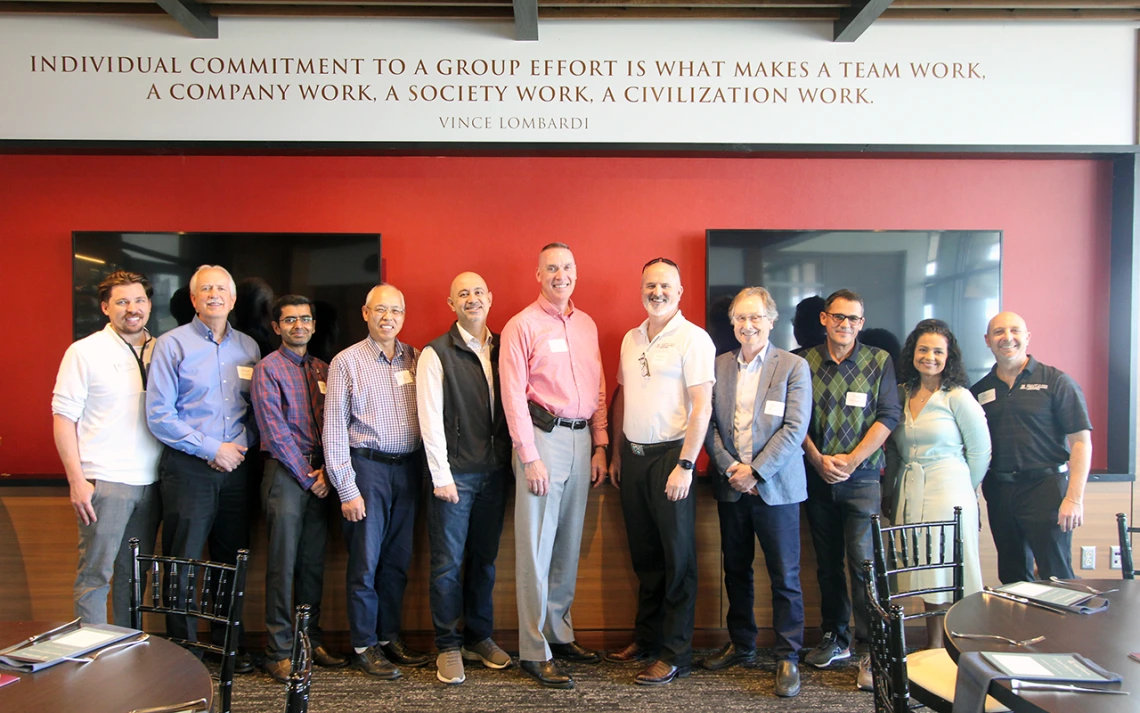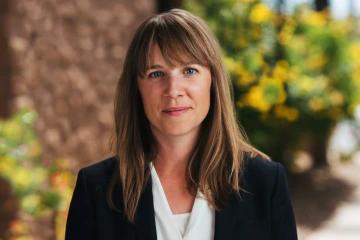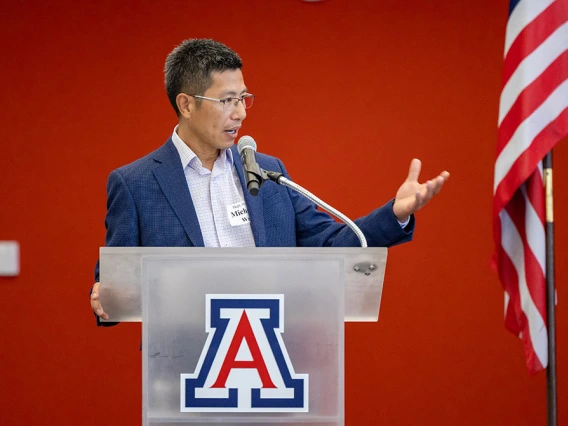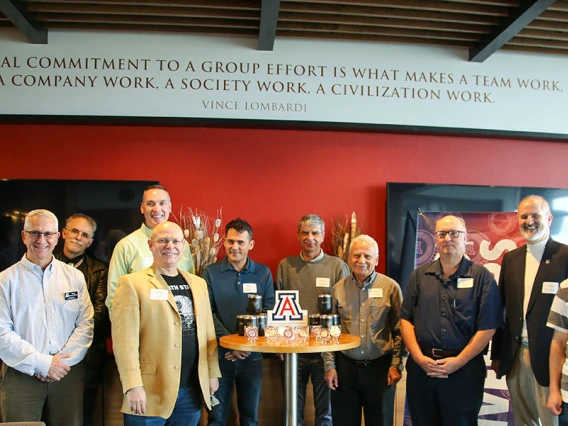2025 patent luncheon showcases AI-powered software and cell therapy
Engineering and Tech Launch Arizona empower faculty to transform novel ideas into startups and life-saving treatments for patients with irregular heartbeats.

The annual patent medallion luncheon celebrates University of Arizona engineering professors whose market-disrupting inventions often lead to startup businesses.
High above the University of Arizona football field, leaders from Tech Launch Arizona and the College of Engineering gathered at the Arizona Sands Club on March 12 to present medallions to researchers and professors issued patents in the past year.
The U of A ranked 31st globally on the National Academy of Inventors' list of the top 100 universities granted utility patents, with 18% of those patents resulting from the work of college affiliates.
Unlike any other university
“I've been at multiple universities, and the tech transfer operation at the University of Arizona is the best I've experienced in my career,” said Mark Van Dyke, associate dean of research for the college and biomedical engineering professor.
Professors across departments are encouraged to patent inventions fueled by entrepreneurial spirit, leading to the founding of companies, products and continued research outside the U of A.
“We want to provide more opportunities to take the things that you do in the lab and bring them to fruition in some form, as a service or a product out in the marketplace,” Van Dyke added.
Jerzy Rozenblit, University Distinguished Professor of Electrical and Computer Engineering, accepted two medallions. One of his celebrated patents – Adaptive Risk Assessment and Mitigation – has already been commercialized.
“By virtue of my 40th year at the University of Arizona, I've seen a lot in terms of technology transfer. I have had the privilege not only of working with all of you, but I'm also a co-founder of a startup spun through TLA,” said Rozenblit, the Raymond J. Oglethorpe Endowed Chair.
Rozenblit and ECE professor emeritus Roman Lysecky co-founded BG Networks, a cybersecurity startup providing tools that protect electronic products.
Motivated by the FDA’s 2017 recall of half a million cardiac devices that were easily hacked and reprogrammed – putting patients at risk for heart failure – BG Networks developed AnCyRRM, or the Anomaly Detection and Cyber Resilience system. This system combines statistical, probabilistic and machine learning algorithms to detect cyberattacks on electronic components in automobiles and medical devices like pacemakers or insulin pumps.
Growing cells to heal hearts
Jennifer Koevary, adjunct professor in the Department of Biomedical Engineering, was presented with a medallion for a patented method that improves cardiac function.
The method treats heart arrhythmia– an irregular heartbeat caused by faulty electrical signals that disrupt the heart's natural beat – by applying cells directly to a patient’s heart, addressing a condition that affects millions of Americans. The most common form of arrhythmia, known as AFib, is estimated to affect 2.7 to 6.1 million people in the United States, according to Yale Medicine. However, a recent University of California, San Francisco study raised that estimate to 10.5 million U.S. adults in 2024.
"There are some therapies available for people with arrhythmias, but they have a very low success rate and in the worst-case scenario, the patient can die," Koevary said.
The demand for better treatments is urgent, and her method shows promise. In preclinical trials, Koevary and her fellow researchers at the U of A Sarver Heart Center observed an unexpected outcome.
"What is unique about what we're doing and why it was patented is that most people in the field of cell therapy give immune suppression medications to the patients because they need those cells that they're implanting to survive,” she said.
Without the immune suppression, the body's immune system will eliminate those cells, Koevary explained.
“We found that by not suppressing the immune system, we were able to activate the immune system in a positive way to help repair the heart."
This discovery shocked Koevary and the lab's principal investigator Dr. Steve Goldman. The next step will be to identify how the method accomplished that outcome.

Jennifer Koevary is a University of Arizona alumna holding two bachelor’s degrees in mechanical engineering and health sciences, and a doctoral degree in biomedical engineering.
Koevary doesn’t expect the technology to be sold right away, but she has witnessed university technology transfer first-hand.
Outside of the university, Koevary is the chief operating officer and chief financial officer for Avery Therapeutics, a biotechnology company in Tucson. The company was born out of the Sarver Lab after licensing technology from the university 10 years ago.
"The things coming out of the university can lead to further opportunities for future research to build on what's being done here," she continued. "A patent can be the first step in that transition from taking something from research and trying to get it out into the world."
Engineering patents pushing the limits
The following is a full list of Engineering faculty members and graduate students who received medallions.
Aerospace and mechanical engineering
Peiwen Li – Reformer, Reactor & Control Sys for H2 Production
Hermann Fasel – Flow Ctrl for Lam-Turb Trans in High-Speed Flight
Christoph Hader – Flow Ctrl for Lam-Turb Trans in High-Speed Flight
Biomedical engineering
Marvin Slepian – Digital Reflex Quantization and Signature Analysis
Jennifer Koevary – Compositions and Method Improving Cardiac Function
Ali Bilgin – MRI Streak-Artifact Suppression, System and Method
Electrical and computer engineering
Wolfgang Fink – Nanowired Power Sources for Implantable Devices; Systems for Real-Time Signal Processing & Fitting; Automated Network-On-Chip Design
Ivan Djordjevic – FPGA-Based LDPC Codes for Optical Communication; Global Quantum Communications Network; Joint Quantum Key Dist for Post Qtm Cryptosystems
Jerzy Rozenblit – Adaptive Risk Assessment and Mitigation; Adaptive Force Guidance for Laparoscopy Training
Kathleen Melde – Switched-Beam Array & IFN for 60-GHz C2C Comms
Systems and industrial engineering
Eze Ahanonu – Virtual Reality Simulation for Airway Management
Vignesh Subbian – Virtual Reality Simulation for Airway Management



